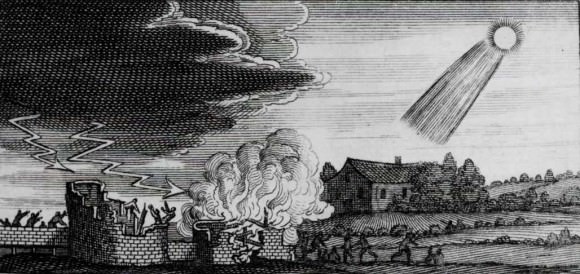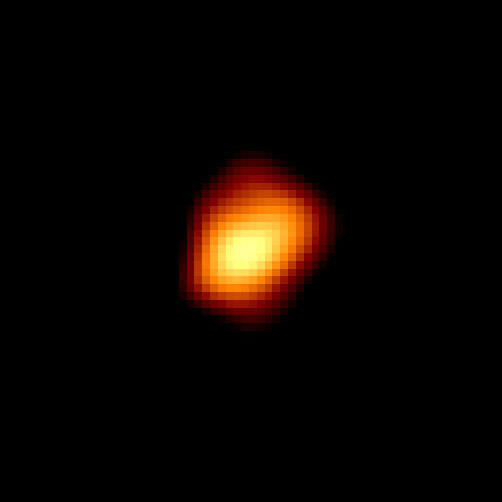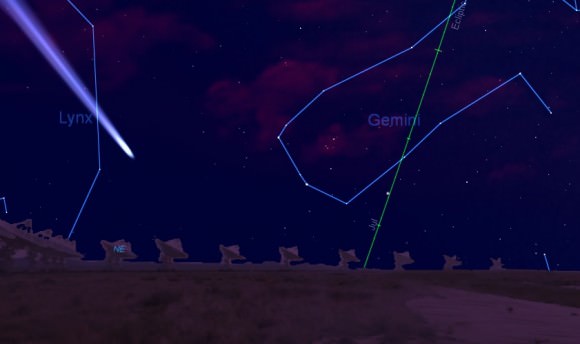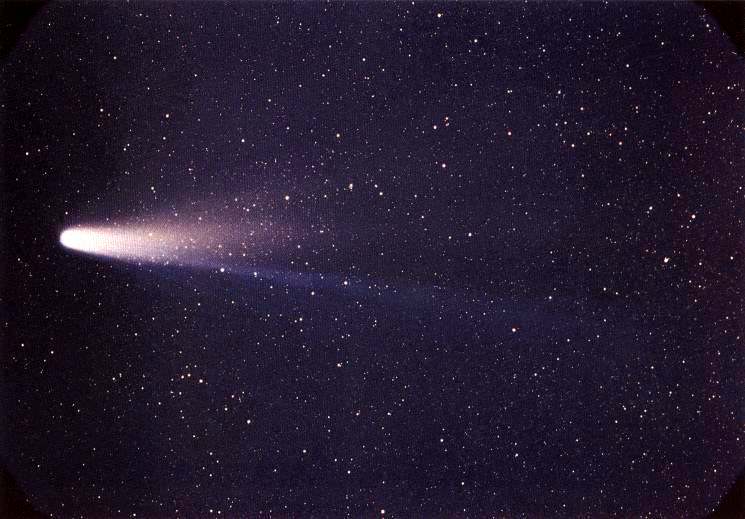An interesting and largely unknown tale of ancient astronomy recently came our way while reading author and astrophysicist Mario Livio’s blog. The story involves the passage of the most famous of all comets.
It’s fascinating to consider ancient knowledge of the skies. While our knowledge of ancient astronomy is often sparse, we know that cultures lived and perished by carefully monitoring the passage of the heavens. A heliacal rising of Sirius might coincide with the impending flooding of the life-giving waters of the Nile, or the tracking of the solstices and equinoxes might mark the start of the seasons.
To the ancients, comets were “hairy stars” which appeared unpredictably in the sky. We generally attribute the first realization that comets are periodic to Sir Edmond Halley, who successfully utilized Newton’s laws of gravity and Kepler’s laws of planetary motion to predict the return of Halley’s Comet in 1758. Such a prediction was a vindication of science.
But an interesting tale comes to us from the 1st century CE that Rabbi & Jewish Scholar Yehoshua Ben Hananiah may have known something of “a star that appears every 70 years.” The tale, as told in the Horayoth (rulings) of the Talmud and described in Mr. Livio’s blog is intriguing:
Rabbi Gamliel and Rabbi Yehoshua went together on a voyage at sea. Rabbi Gamliel carried a supply of bread. Rabbi Yehoshua carried a similar amount of bread and in addition a reserve of flour. At sea, they used up the entire supply of bread and had to utilize Rabbi Yehoshua’s flour reserve. Rabbi Gamliel then asked Rabbi Yehoshua: “Did you know that this trip would be longer than usual, when you decided to carry this flour reserve?” Rabbi Yehoshua answered: “There is a star that appears every 70 years and induces navigation errors. I thought it might appear and cause us to go astray.”
The Rabbi’s assertion is a fascinating one. There aren’t a whole lot of astronomical phenomena on 70 cycles that would have been noticeable to ancient astronomers. With an orbital period of 75.3 years, Halley’s Comet seems to fit the bill the best. The earliest confirmed description of Halley’s comes from Chinese astronomers during its 240 BCE passage. Later subsequent passages of the comet through the inner solar system were noted by the Babylonians in 164 & 87 BCE.
Of course, there’s no further evidence that ancient scholars identified those passages as the same comet. Some great comets such as Hale-Bopp seen in 1997 and this year’s anticipated Comet C/2012 S1 ISON are on orbits spanning thousands of years that outlast most Earthly civilizations.
Mr. Livio also notes that historical knowledge of ancient apparitions of Halley’s may have been accessible to the Great Knesset scholars during the Babylonian exile of the 6th century BCE.
One of the chief objections raised to the Halley hypothesis is the circumstances of the appearance of Halley’s Comet in the Rabbi’s lifetime. Remember, most folks didn’t live for 70 years in the 1st century. Any tales of a periodic comet would have been handed down by generations. You would be lucky to see Halley’s Comet once in your lifetime. Plus, not all apparitions of Halley’s Comet are favorable. For example, Halley’s was bright enough to induce “comet hysteria” with the public in 1910. In contrast, few northern hemisphere members of the general public got a good view of it during its 1986 passage.

Halley’s Comet was visible on and around January 25th, 66 CE during the Rabbi’s lifetime. However, the Rabbi would have been in his 20’s and have been a student (and not yet a Rabbi) himself. One can imagine that if he was fearful of a “false star” leading them astray, he must’ve known that the 70 year period was just about neigh.
The 66 CE apparition of Halley’s Comet would have appeared around the time of the Jewish Rebellion and just four years before the destruction of the Second Temple in Jerusalem by the Romans in 70 CE.
One other possible astronomical culprit has been cited over the years. The classic variable star Mira (Omicron Ceti) currently has a 332 day cycle which ranges from magnitude +3.5 to below naked eye visibility at +8.6 to +10.1. The variability of Mira was first discovered by astronomer David Fabricius on August 3rd 1596. There are suggestions that ancient Chinese and Babylonian astronomers may have known of this “vanishing star”.

Mira is expected to reach maximum for 2013 from July 21st to 31st.
Not all maxima for Mira are of equal brightness. Mira can peak anywhere from magnitude +2.0 to +4.9 (a 15-fold difference) and there’s evidence to suggest it may have been brighter in the past. Astronomer Philippe Veron noted in 1982 that a larger oscillation period of 60 years for the peak maxima of Mira falls just a decade short of Rabbi Yehoshua’s mention of an errant star.
Whatever the case, its fascinating to consider what celestial object might’ve been referred to, and how many other astronomical tales might be awaiting discovery in ancient texts. We’ve got lots of comets to ponder this year as Comet PanSTARRS, Lemmon, and ISON grace our skies in 2013. Halley’s will make its next visit to the inner solar system in 2061. I’ll open it up to you, the astute Universe Today reading public; was the Rabbi’s Star a comet, a variable star, a meteor storm, or none of the above?

-Dr. Mario Livio blogs at A Curious Mind. Be sure to check out his new book Brilliant Blunders: From Darwin to Einstein – Colossal Mistakes by Great Scientists That Changed Our Understanding of Life in the Universe out on May 14th!


I won’t be around for the 2061 arrival of Haley’s comet ( I’d be 112 then!) and wonder if it will be a bright comet in the northern hemisphere?
The 2061 passage of Halley’s comet will indeed be better for northern hemisphere residents, with the comet visible high to the north east at dawn. the simulation in the article was actually run for what will be the morning of my 93rd birthday… I might just make it!
I guess I’ll have to stop smoking, drinking and eating my favorite foods to see the encore. I’d say stopping sex too, but that will be a given! Hehe
It’s 1986 flyby sure sucked. If I live that long, I won’t go out and try to watch it again. I hope they send a space probe to blow it up.
I can’t understand why people have need to linking historical facts with things in the present, it would be a basis of conspirative theories, my be.
Sure that Rabbi had saw Halley comet, but it’s highest unlikely that Halley was a comet before roman-jewist war or the babilonic captivity. First dates in ancient age are less acurate and years are only estimation. Second gravity law is has high precision but solar system has a lot of objects too, and more of them unknowing; Halley in ancient age had deviation on predict orbit that we can’t know today.
For finish how important is? Halley didn’t do importace to the comet, he only made a prediction that confirms gravity theory. Comets passa arround Earth a lots in a life of a person (even in short life of ancient age person), and it’s easy relate any event with passa of some comet.
I think that Rabbi saw a Comet (or other object) even it would be Halley object. But if this object was Halley comet hasn’t any importance historic or astronomic, and we can’t never know.
Halley is only anar other comet and it hasn’t enything special, except the casuality that halley shose it and not other for his prediction
Hi Robert,
I agree with you regarding the basis for conspiracies but using the historical record also allows us access to a much broader data set in terms of observations. Haley himself went back into the historical record to see if his theory of the cyclical nature of the comet held up. He found enough references that fell into the predicted orbit calculations that he was able to predict, with a high degree of certainty, when the comet would next appear. Without that historical record, Haley could not have had the data set needed for his prediction and he would not have been able to present solid proof of Newton or Kepler.
Yes it’s true but Halley took a litle scope of time when a comet of midle period (H. Comet) had passed four times, and he recognized it because it, before beliebed four comets, had a so close orbit and a similar time between them.
But in all pass of halley arround Sun hasn’t the same trajectory. All is into the gravity law, but in its travel Haley is crossing with other objects, same known and others no, and they change its trajectory.
When we look at ancien age we can’t know how acurate is date, because their calendar is differnt of our and correspondence is difficult. Also we can propagate at past orbits of gread objects ( planets, big moons) because the most objects of S.S. are more litle than then but litle objects live in world of caos
Wiht a curiosity in the year of Halley prediction, it must be a litle correction in the halley calculations, nothing out of gravity law. We spect Halley in 2061 but it can return or not depends of what cross in its path.
“When we look at ancien age we can’t know how acurate is date, because
their calendar is differnt of our and correspondence is difficult.”
We might not know, but when there are several sources that all record a comet in a Halley year in a past millenium, then it becomes the best explanation. The people who do this kind of work have many ways of calibrating the dates for that matter.
“We spect Halley in 2061 but it can return or not depends of what cross in its path.” We’ll know a lot sooner if something happens, since we can now observe the comet at any time: http://www.eso.org/public/news/eso0328/ . Anyway, space is big and the most likely outcome is clearly that it’ll return on schedule. I don’t think science has as big problems with figuring this comet out as you’re making it out to have.
Let’s start with the obvious question first.
Is this story fiction or did it really happen?
A lot of bible stories have not historical track record as it never happened in reality.
The thing is, though…we don’t even know that the events in this story happened. This isn’t a historical record, it’s a parable.
Parable only talk Jesus and profets. Biblic or not all ancien text has a problem: credibility.
Current document can be false equal than old but how older is the document less crussed data we have for contrast. The biblic documents or other holy document don’t exeed the minimium of credibility because nothing corroborate its facts relateds, also it happend with any inscription on a wall if we can have proves of it.
Unfurtunely we have only a unique reference of one fact, but lie is constant in all ages
I’m sorry, Robert, I’m not sure I understand what you’re saying. Are you saying that this is not a parable because it is not attributed to Jesus or one of the prophets? I do not think that that is a generally-accepted restriction of the term. If you prefer to refer to it as a Mashal or something else, feel free; but the point remains that its purpose is to be morally instructive, not historically.
No, you can talk about they are alegories or mithologies but not parables because they are a examples no real by strong the speech of Jesus, some prophets use similar forms of transmission their message (strictely no parabole) but prohets usualy relates dreams or direct God comunications.
Both thing aren’t a facts, but the two succes relates in paper are facts (true or no). One is related in Bible but not in Torah other is only a text of Rabbi. If two thing was reality or invent of writer doesn’t change treatament as a fact.
The ancien age (ancien age, midle age, modern age and contemporany age, only for fix terms) text has mithologic and real facts mixted, and moretimes was writteing more after of when it has be, and it always was writteing by winners. Historians have much to discern what really happened, and in global terms a bible text, a papir above a ston or an inscription in a wall are the same. the validation of a fact related in a text only is take with real when there are other sources that mencined it or material proves. The different Between Moises in Red see and Thermopilas batle is that Moises was only mencioning in Bible but Thermopilas Batle we have mentions in Greek and Persian text.
It is indeed a fascinating possibility. But I could raise several objections to this conclusion:
1) Since the rabbi could not himself have observed repeated appearances of the comet, he would have to be relying on received knowledge for other appearances. Since the location, path, appearance and brightness of the comet would differ between appearances, it seems unlikely that he could have identified the comets as the same.
2) This is not an eyewitness account; it is a parable told in the talmud and written long after his death. These stories are not exactly reliable history any more than is Plato’s parable of Atlantis. They are stories told to make a point. It is not at all inconceivable that, knowing the periodic nature of many celestial phenomena, a scholar might have invented the detail of a periodic star.
3) The context itself seems to suggest that the detail was not meant to be historical. Ancient celestial navigation, like today’s, relied primarily upon the pole star with some recourse to the constellations. A comet would not have disturbed any navigational process even in those days; indeed, ancient seafarers would have known the sky like the back of their hands, and would easily have been able to identify and discount such a star.
On balance, then, I would conclude that this is likely to have been a detail in an apocryphal tale invented by the author to further his instructive aims.
Besides Astronomy, my other hobby is medieval reenactment. I am fascinated by the study of ancient astronomy and what was known and what was surmised by the observers of the time. i am going to hazard a guess that the object spoke of in the story was a variable star and not Comet Haley. As the article points out, 70 years is a very long life span for the time and you would need multiple observations in order to conclude that an object was on any sort of cycle. Since it doesn’t appear that we currently have any other supporting evidence that this object was mentioned earlier, I think we would be hard pressed to associate a comet with the object referred to in the story. Variable stars had much better documentation associated with them and would fit the story much better. Certainly a culture who used stellar navigation would be more confused by the sudden appearance of a bright, fixed star than by an object that moved across the background of fixed stars. Regardless of the actual object, the story is still a fascinating one and is another example of the wealth of knowledge the ancients actually had with regards to astronomy.
No. It is obviously an example of that they lacked extensive knowledge. [/grumbles]
How so?
Because _this_ story was about how they lacked knowledge (no such star et cetera). And you are inventing stuff around it (“would be more confused”, not in evidence).
You are taking real achievements as underpinning this story, which they were not. Those achievements were restricted and not generally known (precisely because the type of religious story we are discussing was substituted for what was actually known at the time), see my longish comment on how this story and its relatives fails miserably.
My peeve was that you take a story and goes in the exact opposite direction of what it tells us.
We don’t have further to go than to astrological texts, which were originally part of religious practices, to see that ancient cultures were monitoring the heavens. (Albeit religiously so, since the many errors and contrafactual beliefs remains.)
Astroarcheology, which this is part of, has no scientific standing. It has been efficiently criticized from without (astronomers) and within, and it has never matured into a fruitful area. It is all to easy to come up with pattern matching between events and/or archaeological structures, especially if you don’t bother to specify the confidence of a match.
Seen here, where various phenomena are tried on, and the timings are handwaved.
But this is why it wasn’t a comet:
Ancients knew the difference between stars and comets. And new stars wouldn’t make “navigation errors”.
Since there is no star with the described properties, this is (surprise, surprise) a myth among the others. These types of texts are famous for their non-historicity. In fact, I haven’t seen *any* match to historical events whatsoever.
The first thing that I have to question, if that story actually happened or made up afterwards and assigned a cosmic event to give the impression that the voyage was somehow miraculous than just a boring sea trip.
Mind if i translate that piece of tekst into: even the best of people can be misled once in a lifetime and preparation saves the day.
With originations from: 70 years = oldest age/ Star = guide light or goal
In the Netherlands we would say: “Saving an apple for the thirst”
70 is one of those numbers like 3, 12, and 40 that are used almost idiomatic in ancient Hebrew. You can never take anything literal when they appear. This is just myth-speak for “a long time”.
Great round of thought-provoking commentary from UT readers… it is indeed quite possible as one reader put it that the Rabbi’s reference was strictly an allegorical one, a lesson stating “always be prepared for the appearance of false stars…” Perhaps its the 70 year reference that makes the tale intriguing in an astronomical sense. Without supporting info we may never know for certainty what if any object the Rabbi was referring to, but it is a fascinating exercise to speculate as “armchair astronomers.”. Ancient astronomers where astute students of the sky and we have much yet to learn in the field of archeoastronomy, whether it be from devices such as the antikythera machine or observations from ancient texts.
Haileys comet appearing would not cause anyone to make “navigational errors”. Thats where the story lacks in logic and credibility.